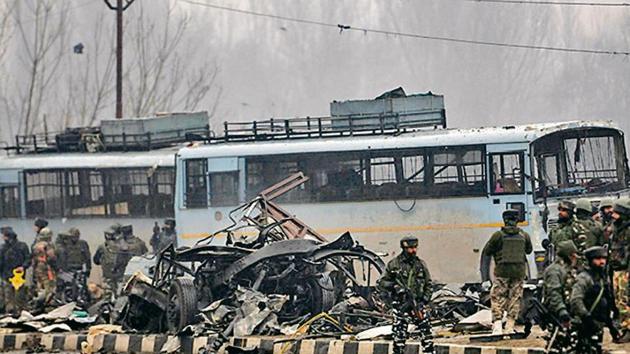Local explosives used to trigger Pulwama attack
The Pulwana attack led to India retaliating with an aerial attack on a terror camp in Balakot and a subsequent dogfight between the air forces of the two countries.
Terrorists who planned and executed the February 14, 2019 Pulwama attack on a Central Reserve Police Force (CRPF) convoy took advantage of pilferage in mineral blocks and stone quarries to procure about 500 gelatin sticks, purchased ammonium nitrate and ammonium powder locally in small tranches, and managed to smuggle in military grade RDX from across the border, according to people familiar with the investigation who gave granular details of the explosives used in the attack that took India and Pakistan to the brink of war last year.

The Pulwama attack -- in which an explosive-laden Maruti Eeco was smashed into the CRPF convoy by suicide bomber Adil Ahmed Dar, killing 40 troopers -- led to India retaliating with an aerial attack on a terror camp in Balakot and a subsequent dogfight between the air forces of the two countries.
A counter-insurgency official, sharing details of how explosive material was collected for the Pulwama bombing, said Jaish-e-Mohammad (JeM) commander Mudassir Ahmed Khan (killed in an encounter in Pinglish on March 11, 2019), Ismail Bhai alias Lambu (currently the main JeM commander in Kashmir), Sameer Ahmed Dar (Jaish’s second-in-command in the Valley) and Shakir Bashir Magrey (arrested by the National Investigation Agency on February 28, 2020) collected the gelatin sticks from the mining blocks and locations used by factories for blasting rocks in the Khrew (Pulwama), Khunmoh (Srinagar), Tral, Awantipora and Lethpora areas over a period of time.
“These gelatin sticks, which have nitroglycerin, were collected in tranches of 5kg to 10kg to avoid raising red flags among the intelligence agencies,” said the official, who asked not to be named.
The ammonium nitrate (around 70 kg) and the ammonium powder were also procured locally in tranches, while around 35kg military grade RDX was brought in from Pakistan, the official added. Some of the ammonium powder was ordered by another Jaish operative, Waiz-ul-Islam (arrested in March 2020 first week), he said.
Forensic experts probing the case have already confirmed that ammonium nitrate, nitroglycerin and RDX were used in the suicide attack.
A senior ministry of home affairs (MHA) official confirmed that NIA had gathered all the evidence on how the explosive material was collected, and who the people behind the delivery were. The RDX, the official said, was brought to India in tranches by JeM terrorists who sneaked into India from Pakistan.
“Gelatin sticks are prohibited for sale in the open market, and only authorised companies or government departments {that} have permission from geology department can use it. However, it has often been seen that there aren’t proper checks at these sites, and explosives used at quarries for blasting mountains/rocks etc. reach the hands of criminals and terrorists. Several advisories have been issued in the past in this regard,” said the MHA official who spoke on condition of anonymity.
The NIA has so far arrested key players in Pulwama attack – including Magrey, Mohammad Abbas Rather, Waiz-ul-Islam, Insha Jan, and her father Tariq Ahmad Shah. They were picked up in the last week of February and first week of March this year.
The agency has also found “definite technical evidence” against the JeM leadership including Maulana Masood Azhar’s brother Abdul Rauf Asghar’s communications with outfit’s commanders in the Valley through which it was established that he was giving directions for the Pulwama conspiracy, a third person familiar with the matter said.
The first charge sheet in the case is expected to be filed in August.
HT reported on March 4, 2020 that the Pulwama attack was originally set to be carried out in the first week of February last year. However, when bad weather in the Valley forced a suspension of the convoy movements , the JeM terrorists waited for the next CRPF convoy to use the Jammu-Srinagar highway on February 14.






